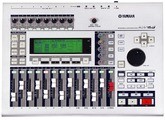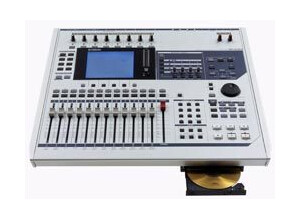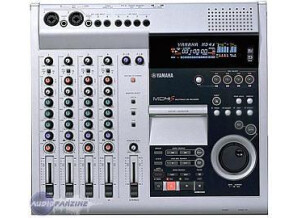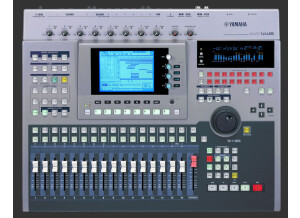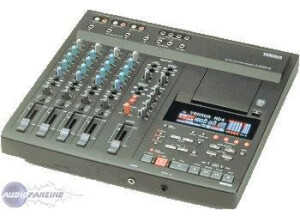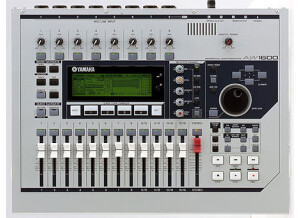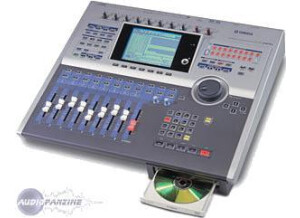Tech. sheet
- Manufacturer: Yamaha
- Model: AW16G
- Category: Digital Multrack-studios
- Other names:aw16g, aw 16g, aw16 g, , multipistesyamaha aw16g, multipistesyamahaaw16g, multipistes yamaha aw 16g, multipistes yamaha aw16 g, multipistesyamahaaw16 g
We have no technical specifications for this product
but your help will be much welcomed
»
User reviews
4.7/5(23 reviews)
5
70 %
4
22 %
3
4 %
2
1
I don't get it
Published on 03/28/13 at 02:12A fat digital unit
The technical features have already been mentioned by other people in the reviews.
UTILIZATION
Headache guaranteed
SOUNDS
When it works, it's nice
The effects are OK, but sometimes (rather frequently) I get lost in the complexity.
OVERALL OPINION
It's certainly a good machine, but, coming from a 4-track tascam cassette recorder, I am totally lost. I don't understand anything. And yamaha interfaces are very particular; you really need some time with them.
The 280-page manual isn't very instructive, in my opinion.
I know my review isn't very comprehensive, but beginners should get a simpler home studio.
I can't see anything to connect it to the computer, only a...…
The technical features have already been mentioned by other people in the reviews.
UTILIZATION
Headache guaranteed
SOUNDS
When it works, it's nice
The effects are OK, but sometimes (rather frequently) I get lost in the complexity.
OVERALL OPINION
It's certainly a good machine, but, coming from a 4-track tascam cassette recorder, I am totally lost. I don't understand anything. And yamaha interfaces are very particular; you really need some time with them.
The 280-page manual isn't very instructive, in my opinion.
I know my review isn't very comprehensive, but beginners should get a simpler home studio.
I can't see anything to connect it to the computer, only a...…
Read more
A fat digital unit
The technical features have already been mentioned by other people in the reviews.
UTILIZATION
Headache guaranteed
SOUNDS
When it works, it's nice
The effects are OK, but sometimes (rather frequently) I get lost in the complexity.
OVERALL OPINION
It's certainly a good machine, but, coming from a 4-track tascam cassette recorder, I am totally lost. I don't understand anything. And yamaha interfaces are very particular; you really need some time with them.
The 280-page manual isn't very instructive, in my opinion.
I know my review isn't very comprehensive, but beginners should get a simpler home studio.
I can't see anything to connect it to the computer, only a cd-rom was supplied and I can't read it. I didn't see anything about it in the manual (did I miss anything?).
The technical features have already been mentioned by other people in the reviews.
UTILIZATION
Headache guaranteed
SOUNDS
When it works, it's nice
The effects are OK, but sometimes (rather frequently) I get lost in the complexity.
OVERALL OPINION
It's certainly a good machine, but, coming from a 4-track tascam cassette recorder, I am totally lost. I don't understand anything. And yamaha interfaces are very particular; you really need some time with them.
The 280-page manual isn't very instructive, in my opinion.
I know my review isn't very comprehensive, but beginners should get a simpler home studio.
I can't see anything to connect it to the computer, only a cd-rom was supplied and I can't read it. I didn't see anything about it in the manual (did I miss anything?).
See less
00
»
A safe bet!
Published on 10/24/11 at 10:5616-track digital mini studio that works at 16 bits/44kHz. It records simultaneously 8 tracks and also has a stereo track to record a master. It uses an internal hard drive to store what your record. The CD player/burner allows you to import (as long as you respect the ISO formatting mentioned in the documentation), export and save an entire project, or parts of it, in wav format. No USB, no SCSI...not very practical, but you get used to it, given the quality of the unit. You have 12 mono and 2 stereo tracks for mixing, as well as 8 levels of independent virtual tracks. No track automation (although it's possible via midi and an external sequencer) but there is a Scene Memory that can be...…
Read more
16-track digital mini studio that works at 16 bits/44kHz. It records simultaneously 8 tracks and also has a stereo track to record a master. It uses an internal hard drive to store what your record. The CD player/burner allows you to import (as long as you respect the ISO formatting mentioned in the documentation), export and save an entire project, or parts of it, in wav format. No USB, no SCSI...not very practical, but you get used to it, given the quality of the unit. You have 12 mono and 2 stereo tracks for mixing, as well as 8 levels of independent virtual tracks. No track automation (although it's possible via midi and an external sequencer) but there is a Scene Memory that can be useful.
In terms of precessing, you have a parametric equalizer (4 freq) and a compressor (expander, limiter, etc...) per channel (inputs+tracks!) whose settings are very comprehensive. 2 very comprehensive multi-effects, too. A (very limited) 4-channel sample player.
For more info see the (lengthy) documentation.
UTILIZATION
The studio is rather well thought-out, although it is not the same in terms of usability as a PC software (but that applies only to the usability!). The track editing functions are laborious, but the results have an impeccable quality. Audio routing is the same as on a standard analog mixer, so it shouldn't pose a problem for people familiar with them. And for those who don't, this mini studio will be useful for the future.
SOUNDS
In my opinion, this is the main strength of this unit, which is why I don't want to let go of it. The converters (16bits/44kHz) are of a very high quality. No converter is transparent, but how can I put it...I prefer them over several 24bit/96kHz ones. The headphone and main outputs are very good, which is ideal for mixing. The EQs, dynamic processors and effects are simple and effective (it's yamaha, remember?...).
OVERALL OPINION
It breathes quality. It's solid. A safe bet, despite the absence of something that seems crucial today in terms of communication with the external world (usb, firewire) but...it's a (nice) unit from another era.
In terms of precessing, you have a parametric equalizer (4 freq) and a compressor (expander, limiter, etc...) per channel (inputs+tracks!) whose settings are very comprehensive. 2 very comprehensive multi-effects, too. A (very limited) 4-channel sample player.
For more info see the (lengthy) documentation.
UTILIZATION
The studio is rather well thought-out, although it is not the same in terms of usability as a PC software (but that applies only to the usability!). The track editing functions are laborious, but the results have an impeccable quality. Audio routing is the same as on a standard analog mixer, so it shouldn't pose a problem for people familiar with them. And for those who don't, this mini studio will be useful for the future.
SOUNDS
In my opinion, this is the main strength of this unit, which is why I don't want to let go of it. The converters (16bits/44kHz) are of a very high quality. No converter is transparent, but how can I put it...I prefer them over several 24bit/96kHz ones. The headphone and main outputs are very good, which is ideal for mixing. The EQs, dynamic processors and effects are simple and effective (it's yamaha, remember?...).
OVERALL OPINION
It breathes quality. It's solid. A safe bet, despite the absence of something that seems crucial today in terms of communication with the external world (usb, firewire) but...it's a (nice) unit from another era.
See less
00
»
Published on 07/10/09 at 14:43
Frequency response: 0 +1/–3 dB, 20 Hz–20 kHz (MIC/LINE IN – STEREO OUT)
Total Harmonic Distortion (THD) (nominal input/output level) 20 kHz LPF: Less than 0.03% 1 kHz (LINE IN to STEREO OUT), Less than 0.2% 1 kHz (MIC IN to STEREO OUT)
Dynamic range (max. level in relation to the noise threshold) IHF-A: 109 dB typ. DA converter (STEREO OUT), 103 dB min. DA converter (STEREO OUT), 103 dB typ. AD + DA (LINE IN to STEREO OUT), 97 dB min. AD + DA (LINE IN to STEREO OUT)
24 Bit / 64 times oversampling AD converter
24 Bit / 128 times oversampling DA converter
32 bit internal processing
Sampling rate: 44.1 kHz (±6%, internal), 44.1 kHz (±6%, external)
Audio input section: MIC/LINE x 8 channels,...…
Total Harmonic Distortion (THD) (nominal input/output level) 20 kHz LPF: Less than 0.03% 1 kHz (LINE IN to STEREO OUT), Less than 0.2% 1 kHz (MIC IN to STEREO OUT)
Dynamic range (max. level in relation to the noise threshold) IHF-A: 109 dB typ. DA converter (STEREO OUT), 103 dB min. DA converter (STEREO OUT), 103 dB typ. AD + DA (LINE IN to STEREO OUT), 97 dB min. AD + DA (LINE IN to STEREO OUT)
24 Bit / 64 times oversampling AD converter
24 Bit / 128 times oversampling DA converter
32 bit internal processing
Sampling rate: 44.1 kHz (±6%, internal), 44.1 kHz (±6%, external)
Audio input section: MIC/LINE x 8 channels,...…
Read more
Frequency response: 0 +1/–3 dB, 20 Hz–20 kHz (MIC/LINE IN – STEREO OUT)
Total Harmonic Distortion (THD) (nominal input/output level) 20 kHz LPF: Less than 0.03% 1 kHz (LINE IN to STEREO OUT), Less than 0.2% 1 kHz (MIC IN to STEREO OUT)
Dynamic range (max. level in relation to the noise threshold) IHF-A: 109 dB typ. DA converter (STEREO OUT), 103 dB min. DA converter (STEREO OUT), 103 dB typ. AD + DA (LINE IN to STEREO OUT), 97 dB min. AD + DA (LINE IN to STEREO OUT)
24 Bit / 64 times oversampling AD converter
24 Bit / 128 times oversampling DA converter
32 bit internal processing
Sampling rate: 44.1 kHz (±6%, internal), 44.1 kHz (±6%, external)
Audio input section: MIC/LINE x 8 channels, DIGITAL IN x 2 channels (optical stereo ×
Audio output section: MONITOR OUT x 2 channels (stereo × 1), PHONES x 2 channels (stereo × 1), STEREO/AUX OUT x 2 channels (stereo × 1), DIGITAL OUT x 2 channels (optical stereo ×
Mixer section: 36 channels in total, MIC/LINE Input x 8, Internal Effect Return x 4, Recorder Monitor x 16, Quick Loop Sampler x 4 Stereo
Internal effects section: Multi-effects × 2
Bus section: 8 buses in total, Bus x 2 (L/R), AUX x 2 (1/2), STEREO x 2 (L/R), Effect x 2 (1/2)
2.5" IDE 20 Gb HDD. Maximum capacity per song: 6.4 Gb
Maximum number of songs: 1,000 songs
Recorder resolution: 16-bit linear (uncompressed)
Maximum number of simultaneous recording/playback tracks: 8 tracks (recording) & 16 tracks /playback)
Number of tracks: 144 (16 tracks + stereo tracks) × 8 virtual
Faders: 13 × 45 mm
MIDI MTC (Master/Slave), MIDI Clock (Master), MMC (Master/Slave), Program Change, Control Change, Bulk Dump
Memory: Scene Memory, EQ Library, Dynamic Library, Effect Library, Channel Library, Sample Library
AC adapter: PA-300
Dimensions (W × H × D): 425mm (16-3/4"), 98.8mm(3-7/8"), 321.5mm (12-3/4")
Weight: 9.7 lbs
MIC/LINE inputs channels 1, 2 (balanced, XLR), +48 V phantom power ±3 V
Input impedance 3kΩ, Nominal input level –46 dB at +4 dB, Minimum input level –52 dB, Maximum output level +18 dB
MIC/LINE inputs channels 3–8 (balanced, TRS jacks), Input impedance 3kΩ, Nominal input level –46 dB at +4 dB, Minimum input level –52 dB, Maximum input level +18 dB
MIC/LINE (HI-Z) input channel 8 (unbalanced, jack), Input impedance 500kΩ, Nominal input level –46 dB at +4 dB, Minimum input level –52 dB, Maximum input level +18 dB
STEREO/AUX OUT L, R (unbalanced, jack), Output impedance 150Ω, Nominal load impedance 10kΩ, Nominal output level –10 dBV, Maximum output level +4 dBV
MONITOR OUT L, R (unbalanced, TRS jack), Output impedance 150Ω, Nominal load impedance 10kΩ, Nominal output level –10 dBV, Maximum output level +4 dBV
PHONES L, R (unbalanced, TRS jack), Nominal load impedance 8–40Ω, Maximum output level 100 mW + 100 mW (40 Ω load)
Optical DIGITAL STEREO I/O
UTILIZATION
Excellent, except for the absence of a USB output and motorized pots, which would be very useful when recalling scenes (which are the settings of a song that you can store).
And a small touchscreen (but I'm being picky here).
Complex manual, but if you practice and use it frequently it's quite logical. Nevertheless, the controls are sometimes tiresome.
A bit slow compared to a computer in certain cases, but it NEVER crashes (and that's priceless).
The routing of external effects to insert them into the mix is pretty lousy and takes up two inputs. Bummer.
I have two, which doubles the possibilities of my home studio (a master and a slave), and it also allows me to record outdoors at leisure.
SOUNDS
You get out what you put in.
Parametric EQ on every input and every track so you can sculpt your sound the way you want it, and it flatters the ears. The broad possibilities allow you to correct certain "cheap" links in your chain.
The converters seem relatively neutral, I can't hear any sound coloration.
It doesn't provide any particular color and it's not a Neve or an SSL, you can be sure of that.
Careful with the input level, it clips pretty easily and the result is degraded.
If you set the compressors correctly you won't get any pumping.
Slightly brilliant in the high mids, the mastering section is effective but you will need external processors to complement it.
In short, if it grooves at the input, it grooves at the output.
OVERALL OPINION
After having hesitated between this one and the Korg D1600, I don't regret anything.
Even if you are limited for live recordings by the 8 inputs (despite having 16), in the studio, the individual assignation of parametric EQs and dynamic processors to every input, which can be then retouched on every track, makes everything fine.
The effects processor has only two channels, but the possibility to assign them during the rough mix allows you to insert others into other tracks, etc., up to the final mix, so you can go very far with this recorder.
P.S.: Most factory presets are pretty bad, regardless of whether it's for dynamics, effects or EQ, including (and especially) for mastering!
So make your own, save them and everything will be fine!!
You will need to add a multi-band processor at the output to get real studio-like results.
Total Harmonic Distortion (THD) (nominal input/output level) 20 kHz LPF: Less than 0.03% 1 kHz (LINE IN to STEREO OUT), Less than 0.2% 1 kHz (MIC IN to STEREO OUT)
Dynamic range (max. level in relation to the noise threshold) IHF-A: 109 dB typ. DA converter (STEREO OUT), 103 dB min. DA converter (STEREO OUT), 103 dB typ. AD + DA (LINE IN to STEREO OUT), 97 dB min. AD + DA (LINE IN to STEREO OUT)
24 Bit / 64 times oversampling AD converter
24 Bit / 128 times oversampling DA converter
32 bit internal processing
Sampling rate: 44.1 kHz (±6%, internal), 44.1 kHz (±6%, external)
Audio input section: MIC/LINE x 8 channels, DIGITAL IN x 2 channels (optical stereo ×
Audio output section: MONITOR OUT x 2 channels (stereo × 1), PHONES x 2 channels (stereo × 1), STEREO/AUX OUT x 2 channels (stereo × 1), DIGITAL OUT x 2 channels (optical stereo ×
Mixer section: 36 channels in total, MIC/LINE Input x 8, Internal Effect Return x 4, Recorder Monitor x 16, Quick Loop Sampler x 4 Stereo
Internal effects section: Multi-effects × 2
Bus section: 8 buses in total, Bus x 2 (L/R), AUX x 2 (1/2), STEREO x 2 (L/R), Effect x 2 (1/2)
2.5" IDE 20 Gb HDD. Maximum capacity per song: 6.4 Gb
Maximum number of songs: 1,000 songs
Recorder resolution: 16-bit linear (uncompressed)
Maximum number of simultaneous recording/playback tracks: 8 tracks (recording) & 16 tracks /playback)
Number of tracks: 144 (16 tracks + stereo tracks) × 8 virtual
Faders: 13 × 45 mm
MIDI MTC (Master/Slave), MIDI Clock (Master), MMC (Master/Slave), Program Change, Control Change, Bulk Dump
Memory: Scene Memory, EQ Library, Dynamic Library, Effect Library, Channel Library, Sample Library
AC adapter: PA-300
Dimensions (W × H × D): 425mm (16-3/4"), 98.8mm(3-7/8"), 321.5mm (12-3/4")
Weight: 9.7 lbs
MIC/LINE inputs channels 1, 2 (balanced, XLR), +48 V phantom power ±3 V
Input impedance 3kΩ, Nominal input level –46 dB at +4 dB, Minimum input level –52 dB, Maximum output level +18 dB
MIC/LINE inputs channels 3–8 (balanced, TRS jacks), Input impedance 3kΩ, Nominal input level –46 dB at +4 dB, Minimum input level –52 dB, Maximum input level +18 dB
MIC/LINE (HI-Z) input channel 8 (unbalanced, jack), Input impedance 500kΩ, Nominal input level –46 dB at +4 dB, Minimum input level –52 dB, Maximum input level +18 dB
STEREO/AUX OUT L, R (unbalanced, jack), Output impedance 150Ω, Nominal load impedance 10kΩ, Nominal output level –10 dBV, Maximum output level +4 dBV
MONITOR OUT L, R (unbalanced, TRS jack), Output impedance 150Ω, Nominal load impedance 10kΩ, Nominal output level –10 dBV, Maximum output level +4 dBV
PHONES L, R (unbalanced, TRS jack), Nominal load impedance 8–40Ω, Maximum output level 100 mW + 100 mW (40 Ω load)
Optical DIGITAL STEREO I/O
UTILIZATION
Excellent, except for the absence of a USB output and motorized pots, which would be very useful when recalling scenes (which are the settings of a song that you can store).
And a small touchscreen (but I'm being picky here).
Complex manual, but if you practice and use it frequently it's quite logical. Nevertheless, the controls are sometimes tiresome.
A bit slow compared to a computer in certain cases, but it NEVER crashes (and that's priceless).
The routing of external effects to insert them into the mix is pretty lousy and takes up two inputs. Bummer.
I have two, which doubles the possibilities of my home studio (a master and a slave), and it also allows me to record outdoors at leisure.
SOUNDS
You get out what you put in.
Parametric EQ on every input and every track so you can sculpt your sound the way you want it, and it flatters the ears. The broad possibilities allow you to correct certain "cheap" links in your chain.
The converters seem relatively neutral, I can't hear any sound coloration.
It doesn't provide any particular color and it's not a Neve or an SSL, you can be sure of that.
Careful with the input level, it clips pretty easily and the result is degraded.
If you set the compressors correctly you won't get any pumping.
Slightly brilliant in the high mids, the mastering section is effective but you will need external processors to complement it.
In short, if it grooves at the input, it grooves at the output.
OVERALL OPINION
After having hesitated between this one and the Korg D1600, I don't regret anything.
Even if you are limited for live recordings by the 8 inputs (despite having 16), in the studio, the individual assignation of parametric EQs and dynamic processors to every input, which can be then retouched on every track, makes everything fine.
The effects processor has only two channels, but the possibility to assign them during the rough mix allows you to insert others into other tracks, etc., up to the final mix, so you can go very far with this recorder.
P.S.: Most factory presets are pretty bad, regardless of whether it's for dynamics, effects or EQ, including (and especially) for mastering!
So make your own, save them and everything will be fine!!
You will need to add a multi-band processor at the output to get real studio-like results.
See less
00
»
Published on 11/07/08 at 11:10
OK. There's no way I can cover everything here, but I'll give you the most important characteristics among those I actually use.
There are eight mono and four stereo tracks, and then another stereo track to which you mix down. Each track (as long as you count a stereo track - e.g. 9/10 - as one rather than two tracks) has independent dynamics processing (compressor, expander, gate) and independent four-band fully parametric eq. You can run two effects at a time.
There are two xlr inputs, six 1/4 inch balanced inputs, and one unbalanced, hi-impedance, 1/4 inch input for recording guitar or bass direct. One of the on board effects is a decent amp simulator (includes cabinet modeling and...…
There are eight mono and four stereo tracks, and then another stereo track to which you mix down. Each track (as long as you count a stereo track - e.g. 9/10 - as one rather than two tracks) has independent dynamics processing (compressor, expander, gate) and independent four-band fully parametric eq. You can run two effects at a time.
There are two xlr inputs, six 1/4 inch balanced inputs, and one unbalanced, hi-impedance, 1/4 inch input for recording guitar or bass direct. One of the on board effects is a decent amp simulator (includes cabinet modeling and...…
Read more
OK. There's no way I can cover everything here, but I'll give you the most important characteristics among those I actually use.
There are eight mono and four stereo tracks, and then another stereo track to which you mix down. Each track (as long as you count a stereo track - e.g. 9/10 - as one rather than two tracks) has independent dynamics processing (compressor, expander, gate) and independent four-band fully parametric eq. You can run two effects at a time.
There are two xlr inputs, six 1/4 inch balanced inputs, and one unbalanced, hi-impedance, 1/4 inch input for recording guitar or bass direct. One of the on board effects is a decent amp simulator (includes cabinet modeling and all the knobs) so recording guitar or bass direct often gets better results than you'd think.
There is also an on board sampler with four trigger pads, and the unit comes preloaded with lots of beats.
UTILIZATION
The AW16G comes with a big, easy to understand manual and an informative (though unintentionally hilarious) dvd to get you started. Once you've spent an afternoon or two recording stuff you'll be completely off book. It has it's own arrangement and everything, but once you've found everything once you'll remember where it is. The organization is comparatively intuitive.
I've recorded a full band on this and gotten great results. I currently use it mostly for recording demos of my songs to give to my band mates. We (my band) normally record with Logic on my friend's Mac, but the other day we were actually recording the drums on the AW16G and transferring them into Logic because we liked the way the A/D conversion and preamps on the AW16G sounded more. True story.
SOUNDS
I'm mostly just recording demos to give to people who have to learn my songs, and so this is actually much better sound quality than I need for that. About four years ago I was in a band that recorded a whole CD on one of these and I was really pleased with the results. If you're really into production and are very picky about sound and control and flexibility, you're probably better off with a computer, but if you just want to get an accurate picture of what a band sounds like, or if you just want something to keep in your bedroom to cook up great sounding demos quickly and easily, this is for you.
My one complaint is that, though there are a lot of beats, they're mostly geared toward hip hop and electronic, and the rock beats are not that cool. I wish there were a lot more of them, because at least then you could pick a slightly lame beat that more perfectly fit the song. I find that I keep using the same three loops over and over, on all my songs. I've done a little bit of sampling from cds adn stuff, but really you should probably get a decent drum machine to go with this.
OVERALL OPINION
When I was a kid, we had to record on four track cassette, and even that seemed like a gift from god. This thing is so much better. As computer stuff gets better, and the AW16G gets older, it seems less and less state of the art, but it's still the best scratch pad I can imaging. I don't use it for "serious" recording projects anymore, but I still use it almost every day.
There are eight mono and four stereo tracks, and then another stereo track to which you mix down. Each track (as long as you count a stereo track - e.g. 9/10 - as one rather than two tracks) has independent dynamics processing (compressor, expander, gate) and independent four-band fully parametric eq. You can run two effects at a time.
There are two xlr inputs, six 1/4 inch balanced inputs, and one unbalanced, hi-impedance, 1/4 inch input for recording guitar or bass direct. One of the on board effects is a decent amp simulator (includes cabinet modeling and all the knobs) so recording guitar or bass direct often gets better results than you'd think.
There is also an on board sampler with four trigger pads, and the unit comes preloaded with lots of beats.
UTILIZATION
The AW16G comes with a big, easy to understand manual and an informative (though unintentionally hilarious) dvd to get you started. Once you've spent an afternoon or two recording stuff you'll be completely off book. It has it's own arrangement and everything, but once you've found everything once you'll remember where it is. The organization is comparatively intuitive.
I've recorded a full band on this and gotten great results. I currently use it mostly for recording demos of my songs to give to my band mates. We (my band) normally record with Logic on my friend's Mac, but the other day we were actually recording the drums on the AW16G and transferring them into Logic because we liked the way the A/D conversion and preamps on the AW16G sounded more. True story.
SOUNDS
I'm mostly just recording demos to give to people who have to learn my songs, and so this is actually much better sound quality than I need for that. About four years ago I was in a band that recorded a whole CD on one of these and I was really pleased with the results. If you're really into production and are very picky about sound and control and flexibility, you're probably better off with a computer, but if you just want to get an accurate picture of what a band sounds like, or if you just want something to keep in your bedroom to cook up great sounding demos quickly and easily, this is for you.
My one complaint is that, though there are a lot of beats, they're mostly geared toward hip hop and electronic, and the rock beats are not that cool. I wish there were a lot more of them, because at least then you could pick a slightly lame beat that more perfectly fit the song. I find that I keep using the same three loops over and over, on all my songs. I've done a little bit of sampling from cds adn stuff, but really you should probably get a decent drum machine to go with this.
OVERALL OPINION
When I was a kid, we had to record on four track cassette, and even that seemed like a gift from god. This thing is so much better. As computer stuff gets better, and the AW16G gets older, it seems less and less state of the art, but it's still the best scratch pad I can imaging. I don't use it for "serious" recording projects anymore, but I still use it almost every day.
See less
00
»










